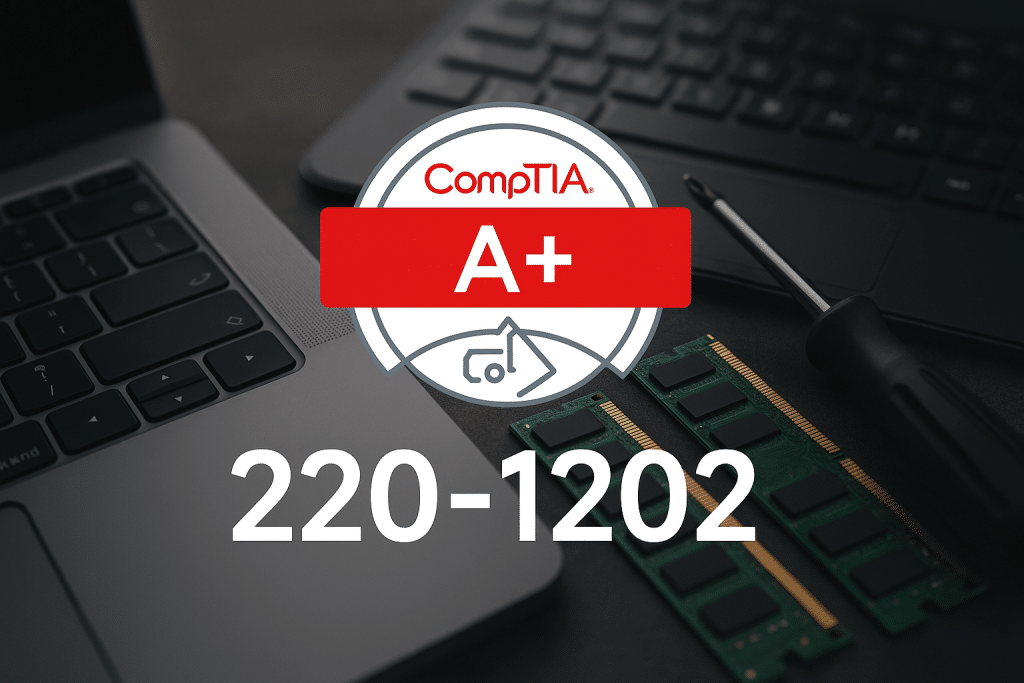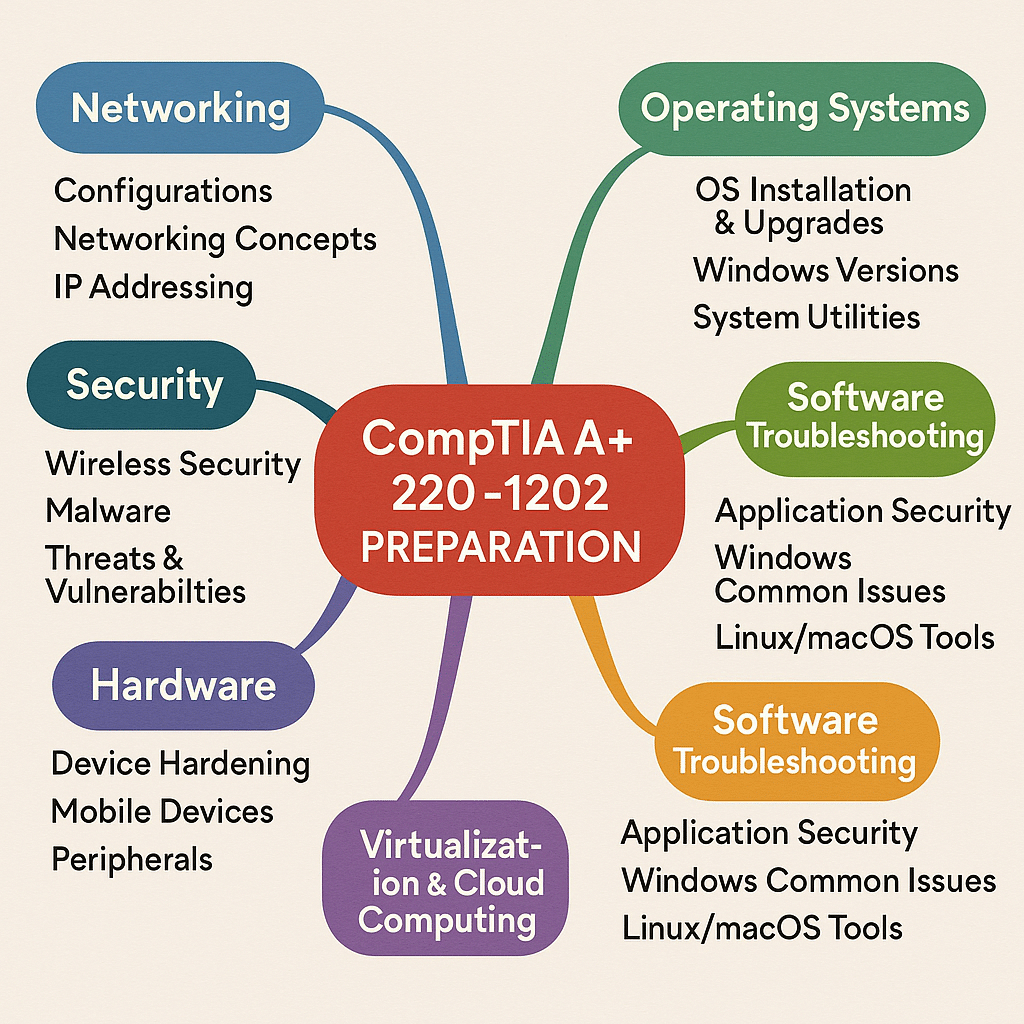
What is CompTIA A+ 220-1202 Exam?
The CompTIA A+ 220-1202 is one of the two exams required to earn the CompTIA A+ Core Series certification, the industry-standard entry-level IT certification. This exam validates practical knowledge and skills related to IT troubleshooting, operating systems, security, software configuration, and advanced support tasks.
It focuses on helping professionals prove they can support and manage today’s business-critical devices and systems; ranging from Windows and Linux OS to mobile platforms, cloud environments, and security protocols. Passing 220-1202 (Core 2), along with 220-1201 (Core 1), grants the globally recognized CompTIA A+ certification.
Who should take THE CompTIA A+ 220-1202 exam?
The 220-1202 exam is designed for:
- Students or recent graduates aiming to qualify for IT support roles.
- Entry-level IT professionals seeking their first certification to break into the tech field.
- Help desk specialists and desktop support technicians who want to validate their real-world troubleshooting skills.
- Career changers moving from non-technical roles into IT.
Prerequisites and recommendations
Official Prerequisites:
- None. CompTIA does not require any prior certifications or experience.
Practical Recommendations:
- Experience level: 6–12 months in IT support, help desk, or similar environments.
- Basic knowledge of computer hardware, software, and networking.
- Familiarity with operating systems like Windows, Linux, macOS, iOS, and Android.
- Prior certifications such as CompTIA IT Fundamentals (ITF+) are helpful but optional.
Exam objectives and domains of CompTIA A+ 220-1202
The CompTIA A+ 220-1202 (Core 2) exam focuses on operating systems, security, software troubleshooting, and operational procedures.
- Domains and Weight:
- Operating Systems – 31%
- Security – 25%
- Software Troubleshooting – 22%
- Operational Procedures – 22%
Objective details by domain
1. Operating Systems (31%)
- Install and configure Windows OS.
- Navigate and use Windows control panel and command-line tools.
- Manage Linux and macOS systems.
- Configure system features and settings.
- Use virtualization and client-side cloud technologies.
2. Security (25%)
- Identify and mitigate common security threats.
- Configure security settings and user permissions.
- Use best practices for secure workstations and mobile devices.
- Manage authentication, encryption, and firewalls.
- Implement malware removal and prevention procedures.
3. Software Troubleshooting (22%)
- Diagnose and resolve application crashes.
- Troubleshoot OS boot and login issues.
- Fix problems related to browsers, apps, and mobile devices.
- Handle performance-related issues (slow response, freezing, etc.).
4. Operational Procedures (22%)
- Apply change management and remote troubleshooting methods.
- Apply best practices for documentation.
- Follow safety and environmental procedures.
- Implement incident response and disaster recovery processes.
- Use professional communication in IT support.
What changed in this version
New topics:
- Cloud-based OS features and virtualization.
- Expanded Linux and macOS troubleshooting.
- Updated security practices (password policies, MFA, zero trust concepts).
Removed/Reduced topics:
- Outdated Windows 7/8 coverage (now Windows 10/11 focus).
Weight shifts:
More focus on security and cloud; slightly reduced emphasis on traditional desktop-only troubleshooting.
Registration and scheduling
- Register through the CompTIA website or Pearson VUE.
- Choose between in-person testing centers or online proctoring.
- Flexible scheduling options are available worldwide.
Pricing and vouchers
Standard price: Around $246 USD per exam (price varies by region).
Discounts available for:
CompTIA bundles (exam + training + retake voucher).
Students (via CompTIA Academic Store).
U.S. military (through DoD programs).
Policies you should know
- Retake policy: No waiting after the first attempt; 14-day wait after 2nd+ attempts.
- ID requirement: Two valid IDs for in-person exams; government ID for online.
- Exam reschedule/cancel: Must be done at least 24 hours before.
- Code of Ethics & NDA: Candidates must accept before the exam starts.
Scoring and results
Scoring scale: 100–900 points.
Passing score: 700 (for 220-1202).
Question types: Multiple choice (single/multiple), drag-and-drop, performance-based.
Results delivery: Immediately after exam completion.
Score report includes: Domain breakdown for strengths and weaknesses.
Exam day and test experience
- On-site testing: Arrive early, check in with ID, leave personal belongings in lockers.
- Online testing: Webcam, mic, and stable internet required; room scan for security.
- Allowed items: None (scratch paper provided on-site; online has digital whiteboard).
- Breaks: No scheduled breaks, but candidates may step away (timer continues).
- Tips:
- Manage time, don’t spend too long on performance-based questions.
- Answer easy questions first.
- Use flagging option for review.
Study plan and resources

For Beginners (12 Weeks)
- Weeks 1–2: Learn computer basics (OS, hardware, networking).
- Weeks 3–6: Deep dive into exam domains (Windows, Linux, security).
- Weeks 7–9: Hands-on labs (virtual machines, troubleshooting scenarios).
- Weeks 10–11: Practice exams and revision of weak areas.
- Week 12: Full-length practice tests and review.
For Experienced Candidates (6 Weeks)
- Weeks 1–2: Refresh OS and security knowledge.
- Weeks 3–4: Focus on practice-based questions and labs.
- Weeks 5–6: Take timed practice exams, simulate test day.
Getting ready for CompTIA A+ 220-1202 doesn’t have to feel overwhelming. The right resources can make all the difference. You can practice with realistic PDF exam questions and test yourself with a free Core 2 practice exam to check your readiness before exam day. Start preparing smartly here:
Download 220-1202 PDF Exam Questions
Try Free 220-1102 Core 2 Practice Exam
Certification validity and renewal
Validity: 3 years from the certification date.
Renewal options:
- Earn a higher-level CompTIA certification (Network+, Security+).
- Earn Continuing Education Units (CEUs) through training or webinars.
- Pass the latest A+ version exam.
Career outcomes after CompTIA A+ 220-1202
Common job titles: Help Desk Technician, IT Support Specialist, Technical Support Analyst, Desktop Support.
Salary range: $45,000–$65,000 annually (varies by location and experience, U.S. average per PayScale/Indeed).
Value at work: Serves as a foundation for IT troubleshooting, system support, and client communication in any business setting.
| Job Role | Typical Salary Range (USD/year) | Description |
|---|---|---|
| Help Desk Technician | $40,000 – $52,000 | Provides first-line support, troubleshooting hardware/software issues. |
| IT Support Specialist | $45,000 – $60,000 | Handles user support, system configuration, and incident resolution. |
| Desktop Support Administrator | $48,000 – $62,000 | Maintains and troubleshoots desktops, laptops, and peripherals. |
| Technical Support Specialist | $46,000 – $63,000 | Focuses on advanced troubleshooting, OS management, and ticket resolution. |
| Service Desk Analyst | $47,000 – $65,000 | Manages support tickets, escalations, and user experience improvements. |
| Associate Network Engineer | $55,000 – $70,000 | Assists with network configuration, monitoring, and connectivity troubleshooting. |
Related or next-step certifications
CompTIA Network+ – for networking fundamentals.
CompTIA Security+ – for cybersecurity basics.
Microsoft or Cisco entry-level certs – for vendor-specific paths.
How this exam compares to similar certifications
- vs. Microsoft 365 Fundamentals (MS-900): A+ is broader, covering hardware, OS, and troubleshooting, while MS-900 is cloud/Office 365-specific.
- vs. Google IT Support Certificate: Google’s program is beginner-friendly and online-based, but CompTIA A+ carries more industry recognition and is often listed in job postings.
Frequently Asked Questions (FAQs)
Do I need hands-on experience before taking CompTIA A+ 220-1202?
It’s not required, but 6–12 months of IT support experience (paid or volunteer) makes the exam much easier. Hands-on practice with operating systems, troubleshooting, and security concepts will boost your confidence.
How hard is the CompTIA A+ 220-1202 exam?
The difficulty depends on your background. For beginners, it can feel challenging because it covers a broad range of topics. With consistent study, labs, and practice tests, most candidates can pass on their first or second try.
Can I take CompTIA A+ exams online from home?
Yes. CompTIA partners with Pearson VUE to offer online proctored exams. You’ll need a webcam, microphone, stable internet, and a quiet, private space for the test.
What happens if I fail the CompTIA A+ 220-1202 exam?
You can retake the exam. There’s no waiting period after your first attempt, but you must wait 14 days after your second or more failed attempts. CompTIA doesn’t limit the number of retakes.
How soon can I use the A+ certification after passing?
Once you pass both 220-1201 and 220-1202, CompTIA immediately updates your certification record. You can start listing CompTIA A+ Certified on your resume and LinkedIn right away.
Will this CompTIA A+ 220-1202 certification expire?
Yes. The CompTIA A+ certification is valid for 3 years. You can renew by earning CEUs, retaking the latest version, or achieving a higher-level CompTIA certification.
Is CompTIA A+ enough to get an IT job?
For many entry-level roles, yes. It shows employers you have a verified foundation in IT. However, pairing A+ with hands-on experience or additional certs like Network+ or Security+ can expand your job opportunities.
Do I have to renew both 220-1201 and 220-1202 separately?
No. The renewal applies to the A+ certification as a whole, not the individual exams. Once certified, you only need to maintain the certification, not each test.
Are there performance-based questions on the exam?
Yes. The A+ includes performance-based questions (PBQs) that simulate real-world troubleshooting. These often take more time, so manage your pacing carefully.


